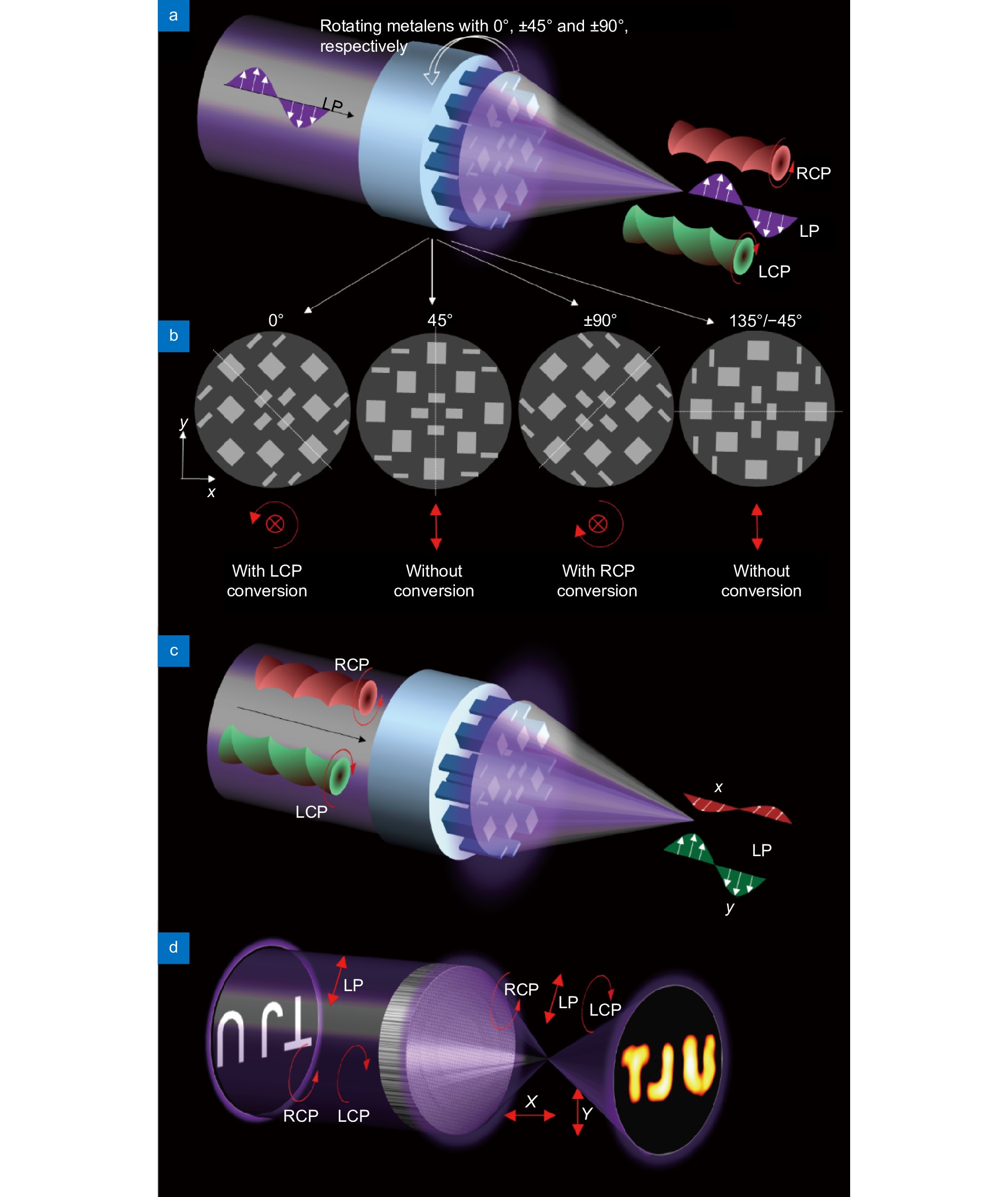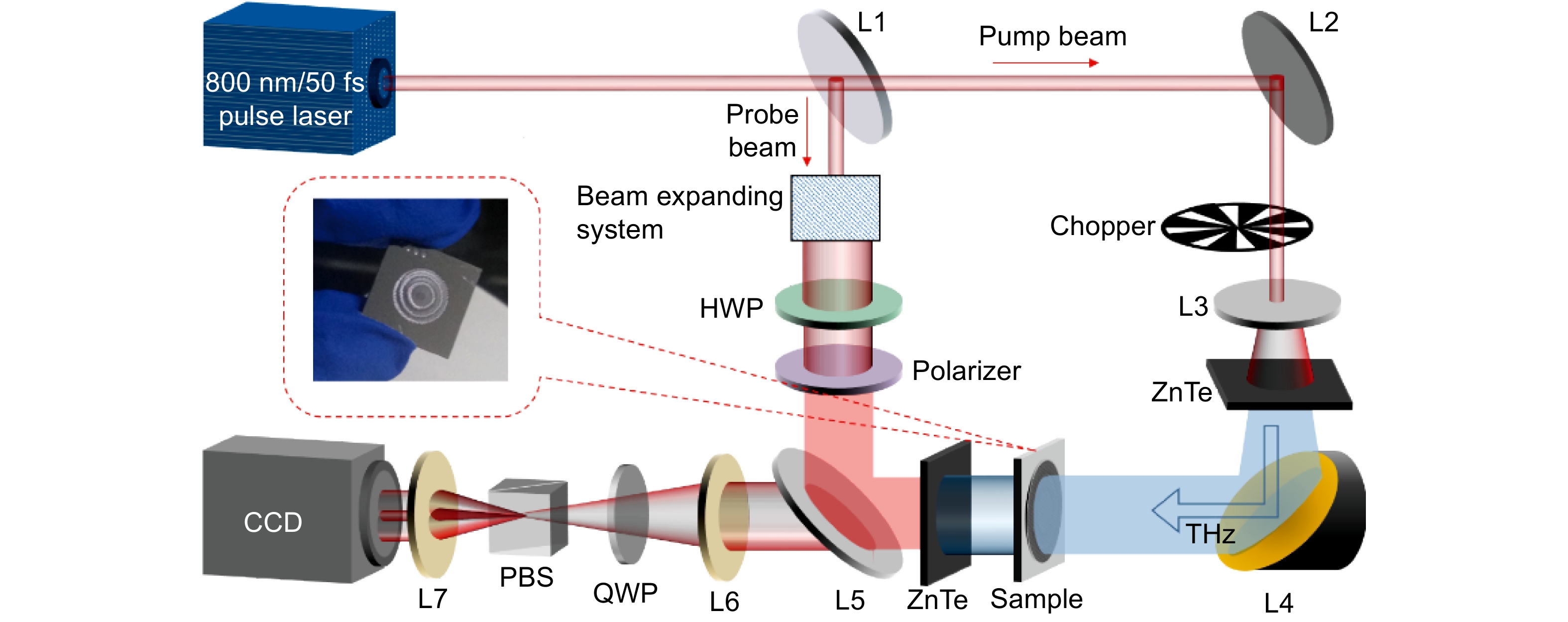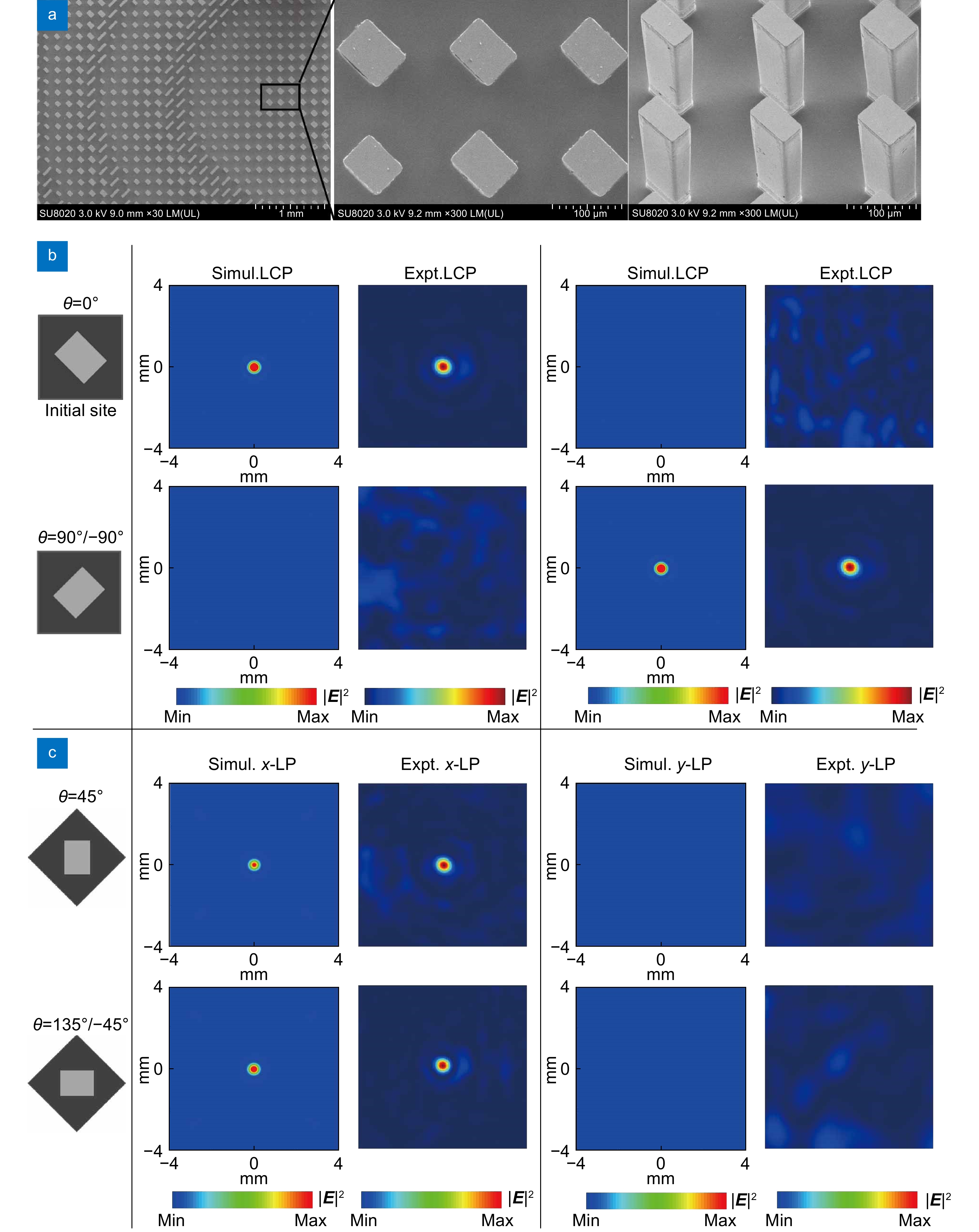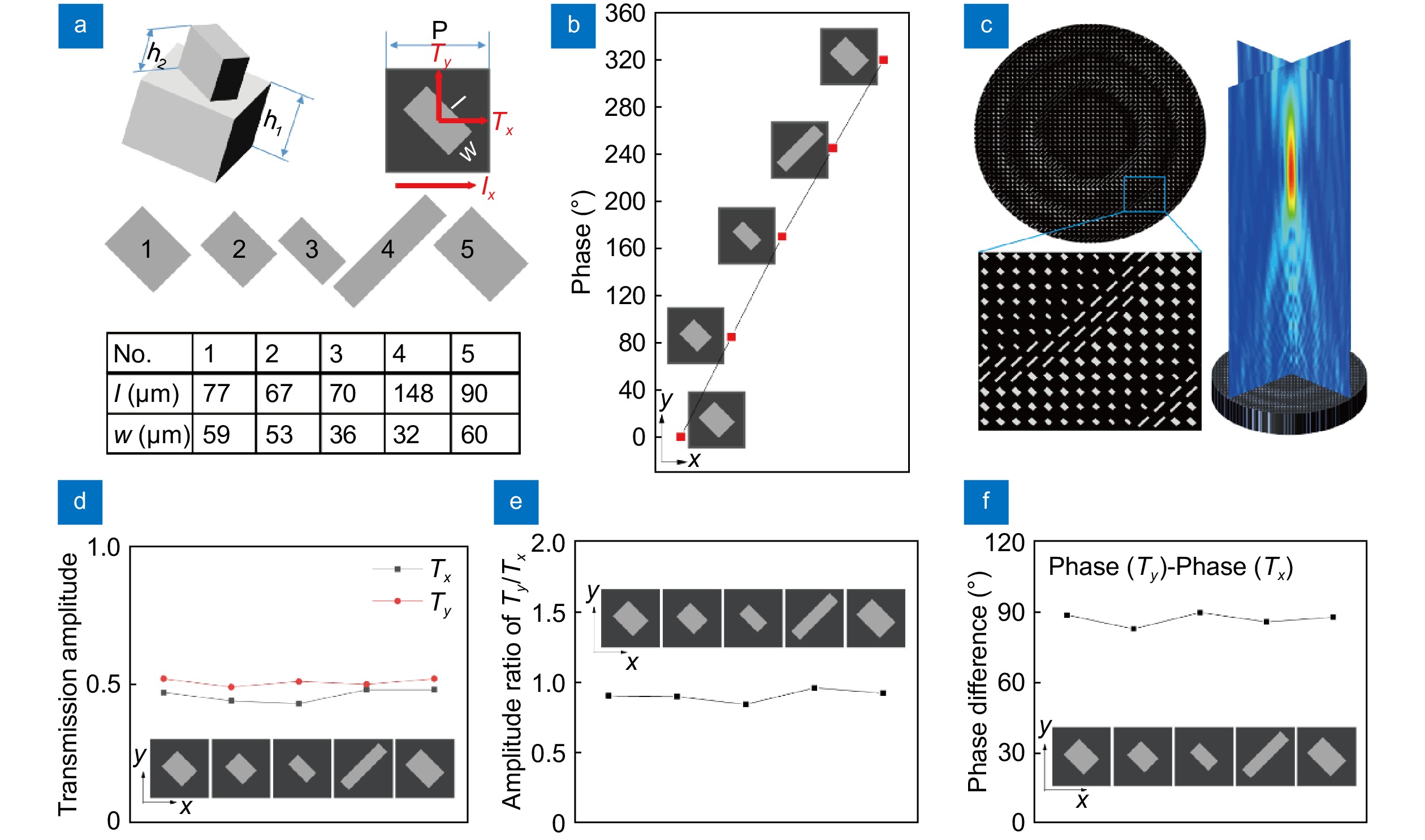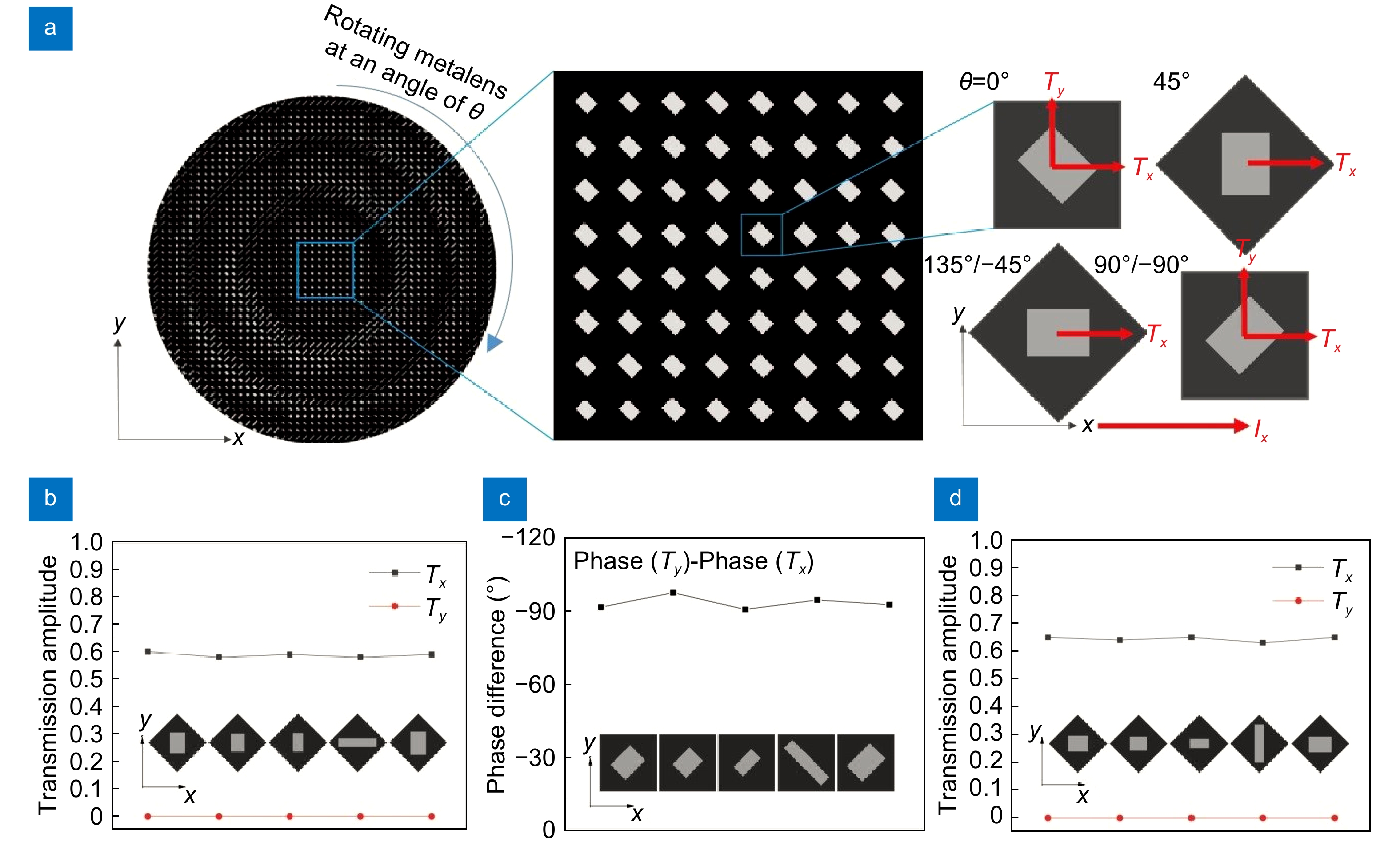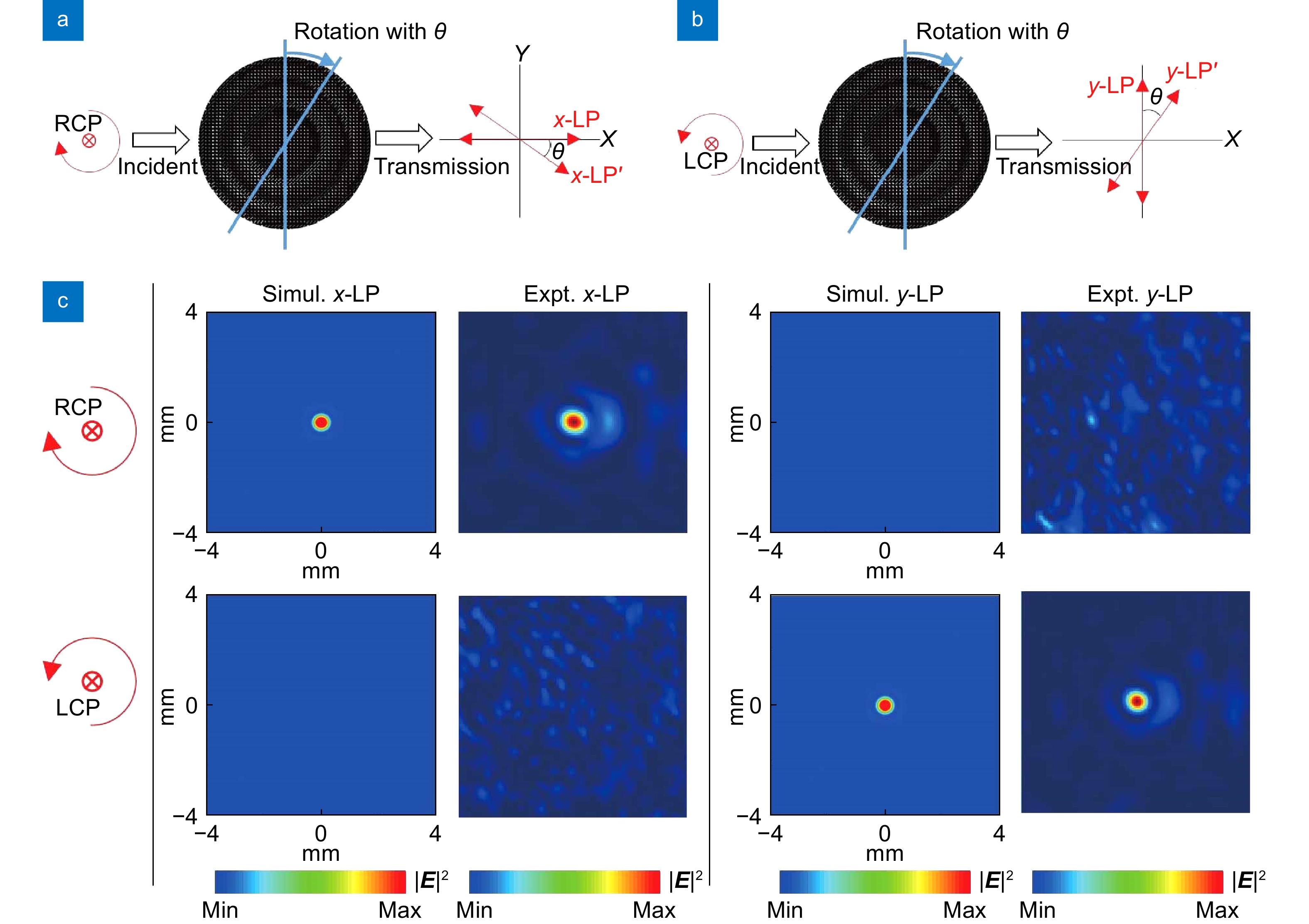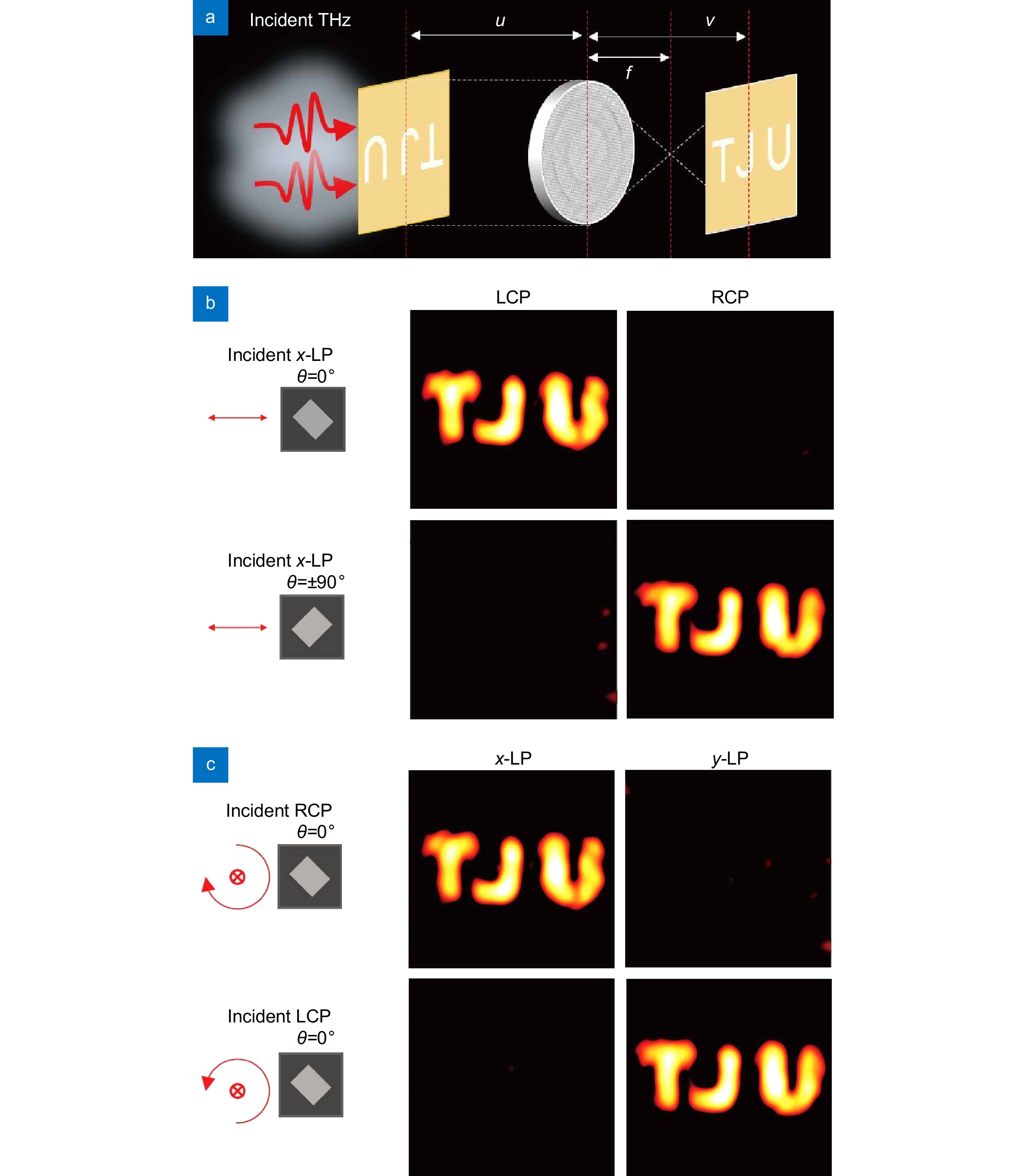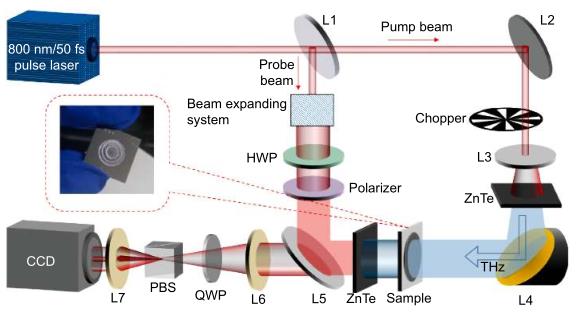-
Abstract
If a metalens integrates the circular polarization (CP) conversion function, the focusing lens together with circular-polarizing lens (CPL) in traditional cameras may be replaced by a metalens. However, in terahertz (THz) band, the reported metalenses still do not obtain the perfect and strict single-handed CP, because they were constructed via Pancharatnam-Berry phase so that CP conversion contained both left-handed CP (LCP) and right-handed CP (RCP) components. In this paper, a silicon based THz metalens is constructed using dynamic phase to obtain single-handed CP conversion. Also, we can rotate the whole metalens at a certain angle to control the conversion of multi-polarization states, which can simply manipulate the focusing for incident linear polarization (LP) THz wave in three polarization conversion states, including LP without conversion, LCP and RCP. Moreover, the polarization conversion behavior is reversible, that is, the THz metalens can convert not only the LP into arbitrary single-handed CP, but also the LCP and RCP into two perpendicular LP, respectively. The metalens is expected to be used in advanced THz camera, as a great candidate for traditional CPL and focusing lens group, and also shows potential application in polarization imaging with discriminating LCP and RCP.
Keywords
-
Introduction
In recent years, researchers have devoted themselves to developing a novel polarization conversion device with lower cost, smaller size, higher integration degree and mutifunctions. Metamaterials/metasurfaces provide a good solution for these new devices1-6. The THz CP conversion devices based on metasurfaces have been developed7. Further, to give full play to the advantages of the metasurfaces, the wavefront control devices combined with phase operation are realized, such as metalens8-21. By arranging different structure units according to a certain phase distribution, the metalens can realize not only the focusing function similar to the traditional convex lens, but also the polarization conversion function22-26. In general, THz metalens widely uses all-dielectric silicon (Si) material with transmission structure so as to meet the practical applications27. If THz metalens can also achieve CP conversion, they can replace both traditional CPL and focus lens, and are used in advanced THz camera, further reducing the camera volume. A very important performance index is that metalens must perfectly convert incident LP light into single-handed CP light, which means the converted CP light can not contain both the left-handed and the right-handed. In the aspect of polarization conversion, the existing THz metalenses have realized the LP rotation22, 25, but the polarization conversion of LP to single-handed CP is not realized. Using the chiral optics and the spin decoupling mechanisms to construct THz metalenses may obtain the conversion and focusing of LP to CP28-30. However, the physical principles of these techniques involves the separation of left-handed circular polarization (LCP) and right-handed circular polarization (RCP) from incident LP, which does not allow the clean and efficient conversion of LP to single-handed CP. In other words, CP conversion in those THz metalenses contains both LCP and RCP components, and it is impossible to completely eliminate one CP but retain the opposite one. As a result, a part of LCP and RCP waves may combine into harmful LP waves again, so that those metalenses cannot still be applied in advanced THz camera.
To overcome mentioned shortcomings in polarization conversion of the existing THz metalenses and expand their multifunctional applications, we designed an all-dielectric Si based THz metalens, which was assembled using dynamic phase (relating to the structural parameters of structure units) and getting rid of the PB phase (relating to rotation of structure units). Some new features appear and are described in Fig. 1. (i) The LP THz wave through metalens will be completely converted into a single-handed CP and then focused at a certain time. Next, we only need to rotate this metalens with
± 45° and± 90° to achieve arbitrary switching among LP, LCP and RCP, as shown in Fig. 1(a-b). This feature shows it can be used in advanced THz camara, as a candidate to replace the group of traditional CPL and focusing lens. (ii) The polarization conversion is reversible, as shown in Fig. 1(c). When a single-handed CP THz wave passes through the metalens, it will be completely converted into LP and focused. Moreover, incident RCP and LCP correspond to two transmission LP waves which are always perpendicular to each other. When this property is used for polarization imaging, the incident RCP and LCP THz waves can be distinguished easily by monitoring transmission LP waves in the image plane, as shown in Fig. 1(d). The polarization imaging function may has a potential application in some fields such as chiral material studies.The metalens must depend on several different structure units those phase can cover 0-2π. Traditionally, the principle of Pancharatnam-Berry (PB) phase is in whole or in part introduced in the phase design of the THz metalens, even for those THz metalenses containing chiral optics and spin decoupling mechanisms28-30. For instance, the general operation is that several basic structures with different structural parameters are firstly designed to meet the phase change of 0-π, and then the phases of the remaining π-2π are obtained by rotating these structures at 90°. Assuming that a basic structure unit can realize the conversion of LP to single-handed CP, the helix of CP will be opposite direction after this structure being rotated by 90° due to the spin dependence of PB phase, which eventually results in the failure of conversion and focusing of LP to single-handed CP in whole metalens. Hence, these intrinsic shortcomings of PB phase in physical principle lead to that the THz metalens integrating the polarization conversion function of LP to single-handed CP has not been realized yet.
Meanwhile, the polarization conversion of the existing metalenses is usually not reversible. Although a LP THz wave through those metalenses is converted into other polarization states and focused, THz wave with other polarization states through those metalenses can no longer be converted into the original LP and focused. These shortcomings also limit the multifunctional applications of the THz metalens to some extent.
There are a lot of linear polarization (LP) light in nature, and many LP light are harmful in photography. They will introduce reflection light into the camera to reduce the clarity and bright-dark contrast of the photo. Polarizer can filter out these harmful LP light, making the color of the photo more saturated and clear. Ordinary cameras usually use a linear-polarizing lens and rotate it to reduce LP light incidence. However, there is still an ignorable remnant of LP light within camera, which still cause some harmful results. In some advanced cameras with auto focus (AF) and automatic exposure (AE), the residual LP light inside the camera will make AF invalid and AE inaccurate. In this case, camera has to depend on the circular-polarizing lens (CPL), which can directly convert the incident LP light into circular polarization (CP) light. For most optical devices, the CP light has no difference with the non-polarized light. Theoretically, the CPL can be used in any camera, including advanced terahertz (THz) camera. However, the preparation of the traditional CPL still depends on manual polishing and sanding, so that the CPL is expensive, low yields and generally large body that is difficult to integrate.
![Figure 1. (a, b) With incident LP, the schematic functions for conversion and focusing of the metalens with different rotation angles. (c) With incident LCP and RCP, the schematic functions for conversion and focusing of the metalens. (d) The schematic THz imaging. The helix directions of LCP and RCP waves correspond to counterclockwise and clockwise rotation of electric field vector when viewed along wave propagation direction, respectively.]()
(a, b) With incident LP, the schematic functions for conversion and focusing of the metalens with different rotation angles. (c) With incident LCP and RCP, the schematic functions for conversion and focusing of the metalens. (d) The schematic THz imaging. The helix directions of LCP and RCP waves correspond to counterclockwise and clockwise rotation of electric field vector when viewed along wave propagation direction, respectively.
Experiments and methods
The metalens model was built in commercial CST Microwave Studio software, and all numerical simulation results were obtained by time-domain solver. The simple silicon (Si) rectangular bar is used as basic structure to construct the metalens, and the structural parameters (height, length and width of Si rectangular bar) of units are selected from a large number of parameter scanning results. The metalens sample used high resistance Si wafer (conductivity δ<0.05 S m–1) with 500 μm thickness, and was prepared using plasma etching method (ICP ion etching machine with SF6 etching gas). The characterization system is shown as Fig. 2. A femtosecond laser outputs a 50 fs duration pulse with 800 nm central wavelength, and it goes through the beam splitter L1 to be separated into a probe beam and a pump beam. The slender pump beam reflected by the mirror L2 is firstly expanded via a concave lens L3 to cover enough the surface (1 cm × 1 cm) of <110> ZnTe crystal, and then induces optical rectification effects to radiate the linear polarization THz wave31. Using a metallic parabolic mirror L4 collimate the THz beam before sample being irradiated by THz wave. THz wave through sample is received by a ZnTe detection crystal. At the same time, the slender probe beam is also expanded by a beam expanding system consisting of a series of lenses, and then adjust probe polarization through a half wave plate (HWP) and a polarizer. The probe beam will be reflected onto the detection crystal by the beam splitter L5. Subsequently, the received THz field excites Pockels effect in ZnTe detection crystal to modulate the polarization of probe beam. Then, the probe beam with polarization modulation through L5 is acquired by CCD camera to form eventually a THz image based on a balanced electro-optics detection technique32. This detection process is essentially the electro-optical sampling33, and this system includes two convex lenses L6 and L7, a quarter wave plate (QWP) and a Wollaston prism (PBS). Besides, it is required to synchronously control the mechanical chopper and CCD camera for using a dynamics subtraction method to eliminate the background intensity of the probe beam.
Results and discussion
Conversion and focusing of LP to arbitrary single-handed CP
{\rm{For}}\; \theta =90^ \circ /-90^ \circ , {\boldsymbol{E}}_2^{{{\rm{t}}}} = {{\boldsymbol{T}}_2}\left( {\begin{array}{*{20}{c}} 1 \\ 0 \end{array}} \right) = \beta \left( {\begin{array}{*{20}{c}} 1 \\ {\rm{i}} \end{array}} \right)\;. \begin{split} {\boldsymbol{T}}_{\boldsymbol{n}}^{'} =\;& {\boldsymbol{H}}{{\boldsymbol{T}}_{\boldsymbol{n}}}{{\boldsymbol{H}}^{ - 1}} = \left( {\begin{array}{*{20}{r}} {{\rm{cos}}\varphi }&{ - {\rm{sin}}\varphi } \\ {{\rm{sin}}\varphi }&{{\rm{cos}}\varphi } \end{array}} \right){{\boldsymbol{T}}_{\boldsymbol{n}}}\left( {\begin{array}{*{20}{r}} {{\rm{cos}}\varphi }&{{\rm{sin}}\varphi } \\ { - {\rm{sin}}\varphi }&{{\rm{cos}}\varphi } \end{array}} \right),\\ & n = 0,1,2,3\;.\\[-10pt] \end{split} The above analyses indicate that we only need to rotate this metalens with
\pm 90° to focus an incident x-LP with arbitrary single-handed CP conversion, respectively. In fact, it is easy to understand that arbitrary LP in x-o-y plane through metalens can also be focused with arbitrary single-handed CP conversion. For instance, if the incident LP has an angle ϕ to x-axis, we can rotate this metalens with an additional angle ϕ on basis of θ rotation angle. Then, this will have the same meaning as the above. Hence, the focusing and conversion of arbitrary LP to arbitrary single-handed CP can be obtained. Here, we can give their general forms. The incident LP with arbitrary direction in x-o-y plane can be obtained by rotating x-LP at an angle of ϕ, thus incident arbitrary LP wave{\boldsymbol{E}}_{\boldsymbol{A}}^{\boldsymbol{i}} in x-o-y plane can be expressed via a base matrix H as follow:At this moment, this situation is equivalent to the an x-LP through the metalens without additional rotation angle ϕ. Eventually, the transmission electric field is expressed:
where
\beta is a coefficient (see section S1). The Si substrate is h1=300 μm, the height of Si bar is h2=200 μm, and the side length of square unit cell is P=160 μm. An x-LP wave through this unit cell will split into a co-polarization component (Tx) and a cross-polarization component (Ty). The two transmission components (Tx and Ty) perpendicular to each other have a phase difference of π/2 and the same amplitude (about 0.5), which composes eventually a LCP wave. If the geometric parameters at length and width of Si bar are changed, which will obtain the phase variations of 0–2π. Five basic structures are found, and their shapes and parameters are as shown in Fig. 3(a). The phases (based on Tx) of five basic structures vary generally from 0 to 2π, as shown in Fig. 3(b). Further, using five basic structures to construct an array meeting phase profile in Eq. (4) can obtain THz metalens, as shown in Fig. 3(c).{{\boldsymbol{T}}_0} = \beta \left( {\begin{array}{*{20}{c}} 1&{ - {\rm{i}}} \\ { - {\rm{i}}}&1 \end{array}} \right)\;, At the first, let us see the polarization conversion property of a rectangular bar. After incident electric field through Si rectangular bar, the universal formation of transmission electric field is as follow:
Further, the metalens should be rotated with an additional angle ϕ on basis of θ rotation angle, and new transfer Jones matrix is:
{\rm{For}}\; \theta =135^ \circ /-45^ \circ , {\boldsymbol{E}}_3^{{{\rm{t}}}} = {{\boldsymbol{T}}_3}\left( {\begin{array}{*{20}{c}} 1 \\ 0 \end{array}} \right) = \sqrt 2 \beta \left( {1 - {\rm{i}}} \right)\left( {\begin{array}{*{20}{c}} 1 \\ 0 \end{array}} \right)\;. {\rm{For}}\; \theta =135^ \circ /-45^ \circ , {{\boldsymbol{T}}_3} = \sqrt 2 \beta \left( {\begin{array}{*{20}{c}} {1 - {\rm{i}}}&0 \\ 0&{1 + {\rm{i}}} \end{array}} \right) \;. \left( {\begin{array}{*{20}{c}} {{\boldsymbol{E}}_x^{\rm{t}}}\\ {{\boldsymbol{E}}_y^{\rm{t}}} \end{array}} \right) = \left( {\begin{array}{*{20}{c}} {{{{t}}_{xx}}}&{{{{t}}_{xy}}}\\ {{{{t}}_{yx}}}&{{{{t}}_{yy}}} \end{array}} \right)\left( {\begin{array}{*{20}{c}} {{\boldsymbol{E}}_x^{\rm{i}}}\\ {{\boldsymbol{E}}_y^{\rm{i}}} \end{array}} \right) = {\boldsymbol{T}}\left( {\begin{array}{*{20}{c}} {{\boldsymbol{E}}_x^{\rm{i}}}\\ {{\boldsymbol{E}}_y^{\rm{i}}} \end{array}} \right)\;, where the wavelength λ corresponds to 0.96 THz, (x, y) belongs to the coordinates of any point in this metalens with setting the origin point (0, 0) at center of metalens, and f=8 mm is the focal length of metalens. Meanwhile, to realize complete and stable LCP conversion, almost the same amplitude and stable phase difference of π/2 are required for two components (Tx and Ty) of every Si bar, as shown in Fig. 3(d–f).
{\boldsymbol{E}}_0^{{\boldsymbol{\rm{t}}}} = {{\boldsymbol{T}}_0}\left( {\begin{array}{*{20}{c}} 1 \\ 0 \end{array}} \right) = \beta \left( {\begin{array}{*{20}{c}} 1 \\ { - {\rm{i}}} \end{array}} \right)\;, Since the phase variations of 0–2π in metalens are achieved by changing structural parameters of Si bars and do not depend on rotation operation of Si bars, this is a dynamic phase assembled THz metalens. Obviously, if any PB phases is introduced in metalens (i.e., traditionally, the phase variations of 0–π in metalens are achieved by changing structural parameters of Si bars, but the phase variations of π–2π are got by 90° rotation operation of the existing Si bars), the polarization conversion of metalens will be complex so that the focusing with pure LCP conversion fails.
Next, we deduce other features of the THz metalens based on Jones matrix (Eq. (2)) of conversion from x-LP to LCP. When the metalens is rotated as a whole, with angles of θ=0°, 45°, 90°, 135°, respectively, every unit cell will be rotated correspondingly as shown in Fig. 4(a). Respectively, new transfer Jones matrices are deduced in Section 2 of Supplementary Information and shown as follows:
The SEM of original metalens is shown in Fig. 5(a). And Fig. 5(b) shows simulative and experimental results in focal plane for focusing and conversion of incident x-LP to transmission CP. In general, these experimental results are well agreement with the simulative results. The original metalens without any rotation (θ=0°) possesses a function of converting x-LP into pure LCP. When metalens is rotated at θ=±90°, x-LP to pure RCP conversion and focusing can be obtained. Further, if we want to keep x-LP focusing without polarization conversion, the metalens can be rotated at θ=±45°, as shown in Fig. 5(c). Overall, the metalens we designed has some practical values, including simple operation, high integration, and easily obtaining arbitrary single-handed CP.
{\rm{For}}\; \theta =90^ \circ /-90^ \circ , {{\boldsymbol{T}}_2} = \beta \left( {\begin{array}{*{20}{c}} 1&{\rm{i}} \\ {\rm{i}}&1 \end{array}} \right)\;. Equations (8) and (10) mean that when the metalens is rotated with ±45°, the transmission waves are still x-LP without polarization conversion. Also, five basic structures show almost the same transmission amplitude, as shown in Fig. 4(b, d). At this moment, the metalens will focus x-LP without polarization conversion. When the metalens is rotated with ±90°, formula (9) show that the transmission RCP conversion will appear. Obviously, the transmission amplitude of two components (Tx and Ty) are same as that before rotating metalens, but two components (Tx and Ty) will have a phase difference of Δφ
=−π/2 as shown in Fig. 4(c), meaning the metalens will convert incident x-LP into RCP and then focus. It can be seen from formula (13) that the final transmission electric field
{\boldsymbol{E}}_{\boldsymbol{n}}^{{\bf{t}}'} is equivalent to rotating the previous transmission electric field{\boldsymbol{E}}_{\boldsymbol{n}}^{\bf{t}} with an additional angle ϕ. The detailed deduction process for Eqs. (11–13) can be seen in Section 3 of Supplementary Information.![Figure 5. (a) The SEM images of the metalens sample. (b) The simulative and experimental results for focusing and conversion of incident x-LP to transmission CP. (c) The simulative and experimental results for focusing of incident x-LP, without polarization conversion. The simulation results in the cross section are shown in Section 4 of Supplementary information.]()
(a) The SEM images of the metalens sample. (b) The simulative and experimental results for focusing and conversion of incident x-LP to transmission CP. (c) The simulative and experimental results for focusing of incident x-LP, without polarization conversion. The simulation results in the cross section are shown in Section 4 of Supplementary information.
Correspondingly, the electric field of transmission waves under incident x-LP are expressed as:
![Figure 3. (a) The schematic five basic structures, and parameters of length ‘l’ and width ‘w’ shown in inset table; Ix: incident x-LP, Tx: co-polarization transmission at x-axis, Ty: cross-polarization transmission at y-axis. (b) The phases based on Tx of five basic structures. (c) The schematic picture of the metalens. (d) The amplitude of Tx and Ty under incident x-LP. (e) The amplitude ratio of Ty/Tx. (f) The phase difference between Tx and Ty.]()
(a) The schematic five basic structures, and parameters of length ‘l’ and width ‘w’ shown in inset table; Ix: incident x-LP, Tx: co-polarization transmission at x-axis, Ty: cross-polarization transmission at y-axis. (b) The phases based on Tx of five basic structures. (c) The schematic picture of the metalens. (d) The amplitude of Tx and Ty under incident x-LP. (e) The amplitude ratio of Ty/Tx. (f) The phase difference between Tx and Ty.
{\rm{For}}\; \theta =45^{\circ}, {{\boldsymbol{T}}_1} = \sqrt 2 \beta \left( {\begin{array}{*{20}{c}} {1 + {\rm{i}}}&0 \\ 0 & {1 - {\rm{i}}} \end{array}} \right)\;. where
{\boldsymbol{E}}_x^{\rm{i}},{\boldsymbol{E}}_y^{\rm{i}} are incident electric field at x-axis and y-axis, respectively, and{\boldsymbol{E}}_x^{\rm{t}},{\boldsymbol{E}}_y^{\rm{t}} are transmission electric field at x-axis and y-axis, respectively. T is the transfer Jones matrix and consists of transmission coefficients tab (a, b∈{x, y}, tab means the coefficient of transmission a-LP under incident b-LP). To obtain LCP conversion under incident x-LP wave (electric field vector\left( 1 \right.\;{\left. 0 \right)^{\rm{T}}} ), the initial site of Si rectangular bar is deduced to 45° deviated from x-axis, as shown in Fig. 3(a). The deduction process is shown in Section 1 of Supplementary Information in detail. The transmission LCP wave{\boldsymbol{E}}_0^{\rm t} and transfer Jones matrix T0 is expressed as follow:\phi = \frac{{2{\rm{\pi}} }}{\lambda }\left( {f - \sqrt {{x^2} + {y^2} + {f^2}} } \right)\;, \begin{split} {\boldsymbol{E}}_{\boldsymbol{n}}^{{\bf{t}}'} =\;& {\boldsymbol{T}}_{\boldsymbol{n}}^{'}{\boldsymbol{E}}_{\boldsymbol{A}}^{\bf{i}} = \left( {\begin{array}{*{20}{r}} {{\rm{cos}}\varphi }&{ - {\rm{sin}}\varphi } \\ {{\rm{sin}}\varphi }&{{\rm{cos}}\varphi } \end{array}} \right){\boldsymbol{E}}_{\boldsymbol{n}}^{\bf{t}} = {\boldsymbol{HE}}_{\boldsymbol{n}}^{\bf{t}}\;,\\ \;&n = 0,1,2,3\;. \end{split} {\rm{For}}\; \theta =45^ \circ , {\boldsymbol{E}}_1^{{{\rm{t}}}} = {{\boldsymbol{T}}_1}\left( {\begin{array}{*{20}{c}} 1 \\ 0 \end{array}} \right) = \sqrt 2 \beta \left( {1 + {\rm{i}}} \right)\left( {\begin{array}{*{20}{c}} 1 \\ 0 \end{array}} \right)\;. ![Figure 4. (a) The schematic change of unit cells when the whole metalens is rotated with θ. (b) When the whole metalens is rotated with 45o, the amplitude of Tx and Ty under incident x-LP. (c) When the whole metalens is rotated with ±90o, the phase difference of Tx and Ty under incident x-LP. (d) When the whole metalens is rotated with 135o/–45o, the phase difference of Tx and Ty under incident x-LP.]()
(a) The schematic change of unit cells when the whole metalens is rotated with θ. (b) When the whole metalens is rotated with 45o, the amplitude of Tx and Ty under incident x-LP. (c) When the whole metalens is rotated with ±90o, the phase difference of Tx and Ty under incident x-LP. (d) When the whole metalens is rotated with 135o/–45o, the phase difference of Tx and Ty under incident x-LP.
{\boldsymbol{E}}_{\boldsymbol{A}}^{\rm{i}} = {\boldsymbol{H}}\left( {\begin{array}{*{20}{c}} 1 \\ 0 \end{array}} \right) = \left( {\begin{array}{*{20}{r}} {{\rm{cos}}\varphi }&{ - {\rm{sin}}\varphi } \\ {{\rm{sin}}\varphi }&{{\rm{cos}}\varphi } \end{array}} \right)\left( {\begin{array}{*{20}{c}} 1 \\ 0 \end{array}} \right) = \left( {\begin{array}{*{20}{c}} {{\rm{cos}}\varphi } \\ {{\rm{sin}}\varphi } \end{array}} \right)\;. The simple Si rectangular bar is used as basic structure to design metalens. Started by a feature that the incident x-LP THz wave through metalens is converted into LCP and focused, we discuss firstly the design process of metalens and then deduce other features.
Conversion and focusing of arbitrary single-handed CP to LP
![Figure 6. (a, b) Respectively, RCP and LCP through the rotated metalens will be converted into a LP having an angle θ to x-axis and y-axis; x-LP and y-LP corresponding to the case without metalens rotation; x-LP’ and y-LP’ corresponding to the case with metalens rotation. (c) The simulative and experimental results for focusing and conversion of incident CP to transmission LP. The simulation results in the cross section are shown in Section 6 in Supplementary Information.]()
(a, b) Respectively, RCP and LCP through the rotated metalens will be converted into a LP having an angle θ to x-axis and y-axis; x-LP and y-LP corresponding to the case without metalens rotation; x-LP’ and y-LP’ corresponding to the case with metalens rotation. (c) The simulative and experimental results for focusing and conversion of incident CP to transmission LP. The simulation results in the cross section are shown in Section 6 in Supplementary Information.
While LCP through metalens will be converted into a LP having an angle θ to y-axis with an additional phase shift (π/2−θ), as shown in Fig. 6(b), and the general form is expressed as follow:
{\boldsymbol{E}}_5^{\bf{t}} = {{\boldsymbol{T}}_0}\left( {\begin{array}{*{20}{c}} 1 \\ { - {\rm{i}}} \end{array}} \right) = \beta \left( {\begin{array}{*{20}{c}} 1&{ - {\rm{i}}} \\ { - {\rm{i}}}&1 \end{array}} \right)\left( {\begin{array}{*{20}{c}} 1 \\ { - {\rm{i}}} \end{array}} \right) = - 2\beta \left( {\begin{array}{*{20}{c}} 0 \\ 1 \end{array}} \right)\;. {\boldsymbol{E}}_4^{{\bf{t}}'} = 2\beta {{\rm{e}}^{\rm{i}}}^\theta \left( {\begin{array}{*{20}{c}} {{\rm{cos}}\theta } \\ {{\rm{sin}}\theta } \end{array}} \right)\;. {\boldsymbol{E}}_5^{{\bf{t}}'} = - 2\beta {{\rm{e}}^{{\rm{i}}\left( {\frac{{\rm{\pi}}}{2} - \theta } \right)}}\left( {\begin{array}{*{20}{r}} {-{\rm{ sin}}\theta } \\ {{\rm{cos}}\theta } \end{array}} \right)\;. {\boldsymbol{E}}_4^{\bf{t}} = {{\boldsymbol{T}}_0}\left( {\begin{array}{*{20}{c}} 1 \\ {\rm{i}} \end{array}} \right) = \beta \left( {\begin{array}{*{20}{c}} 1&{ - {\rm{i}}} \\ { - {\rm{i}}}&1 \end{array}} \right)\left( {\begin{array}{*{20}{c}} 1 \\ {\rm{i}} \end{array}} \right) = 2\beta \left( {\begin{array}{*{20}{c}} 1 \\ 0 \end{array}} \right)\;. Further, we can rotate the metalens to change direction of transmission LP. Here, we have also deduced their general forms in Section 5 of Supplementary Information, and results are given as follows. Assuming that metalens is rotated with an angle θ, then RCP through metalens will be converted into a LP having an angle θ to x-axis with an additional phase shift θ, as shown in Fig. 6(a), and the general form is expressed as follow:
The reversible polarization conversion is another characteristic of this metalens, that is, the metalens can convert not only incident LP into single-handed CP, but also incident single-handed CP into LP. For original metalens without any rotation (θ=0°), the incident RCP and LCP are transferred by Jones matrix T0, and transmission fields
{\boldsymbol{E}}_{\boldsymbol{n}}^{\boldsymbol{t}} (n=4, 5) as follows:In other words, to obtain conversion and focusing of arbitrary CP to arbitrary LP, we only need to rotate the metalens at a corresponding angle of target LP. Meanwhile, it is easy to understand that no matter how many angles the metalens rotates, the transmission LP waves corresponding to incident RCP and LCP are always perpendicular to each other. To verify the mentioned theory analyses, Fig. 6(c) shows simulative and experimental results for focusing and conversion of incident CP to transmission LP. Because the transmission LP before and after metalens rotation has a corresponding relationship, we only need to present the results in term of original metalens (θ=0°) here. It can be seen from Fig. 6(c) that the original metalens has the function of converting RCP into y-LP and converting LCP into x-LP, which verifies the mentioned theory analyses well.
The above two formulas show that RCP through original metalens will be converted into an x-LP and focused, while LCP through this metalens will be converted into a y-axis LP (y-LP) and focused.
THz imaging applications
The imaging results of THz focusing metalens are simulated. As long as a certain object-image relationship is satisfied, the ‘TJU’ pattern can be presented in image plane. As shown in Fig. 7(a), the object-image relationship is 1/f=1/u+1/v, where f=8 mm is focal length, and u=v=16 mm are object distance and image distance, respectively. We simulate firstly the CP imaging properties of metalens under incident x-LP, as shown Fig. 7(b). Due to LCP conversion, the original metalens possesses LCP imaging property well while there is no RCP imaging property. In contrast, since the RCP conversion appears as rotating metalens at ±90°, the metalens will present well RCP imaging property while there is no LCP imaging property. These results reveal that this metalens can be used in advanced THz camera, as a great candidate of traditional CP conversion and focusing device group.
In some fields, it is necessary to distinguish RCP and LCP. For instance, many natural and artificial materials such as chiral molecules can emit LCP wave (or induce LCP conversion), which are called left-handed materials, and vice versa are called right-handed materials. If the spin direction of these CP waves cannot be detected, the chiral properties of materials can not be distinguished. Here, this metalens we designed may provide a useful idea to distinguish LCP and RCP. It has been proposed in conversion and focusing of arbitrary single-handed CP to LP section that no matter how to rotate metalens, two transmission LP waves under incident RCP and LCP are always perpendicular to each other, which means two transmission LP waves have no overlapping components at all. Hence, incident RCP and LCP can be distinguished completely in polarization states by monitoring different transmission LP states. As shown in Fig. 7(c), the simulation show the original metalens under incident RCP can obtain x-LP imaging property well but no y-LP imaging property. Further, y-LP imaging property can be obtained under incident LCP, without any x-LP imaging property. These results indicate that this metalens may also be applied in polarization imaging field with LCP and RCP discrimination.
Conclusions
In this paper, to construct a metalens integrating single-handed CP conversion, an all-dielectric Si based THz metalens was designed using dynamic phase, without any PB phase. Simulative and experimental results show that LP THz wave through metalens can be converted into arbitrary single-handed CP THz wave and then focused. As a fixed incident x-LP, when this metalens is rotated with ±45° and ±90°, three transmission polarization states can be obtained, including LP without conversion, LCP and RCP. Meanwhile, the polarization conversion is reversible. The arbitrary single-handed CP THz wave through the metalens can also be converted into LP THz wave and then focused. Respectively, RCP and LCP through the metalens are converted into x-LP and y-LP. And no matter how many angles the metalens rotates, the corresponding two transmission LP waves under incident RCP and LCP are always perpendicular to each other. Further, the THz imaging properties of the metalens are also verified by simulation. Results show that the metalens can be expected to become a great candidate of CP conversion and focusing device in advanced THz camera. Moreover, the metalens can be used in polarization imaging field requiring LCP and RCP discrimination, such as chiral material studies, in which the incident RCP and LCP will be distinguished easily by monitoring transmission LP states in the image plane.
Acknowledgements
This work was supported by the National Natural Science Foundation of China (Nos. 61675147, 61735010 and 91838301), National Key Research and Development Program of China (No. 2017YFA0700202), Basic Research Program of Shenzhen (JCYJ20170412154447469).
-
References
[1] Wu PC, Tsai WY, Chen WT, Huang YW, Chen TY et al. Versatile polarization generation with an aluminum plasmonic metasurface. Nano Lett 17, 445–452 (2017).
DOI: 10.1021/acs.nanolett.6b04446[2] Cheng YZ, Fan JP, Luo H, Chen F. Dual-band and high-efficiency circular polarization convertor based on anisotropic metamaterial. IEEE Access 8, 7615–7621 (2020).
DOI: 10.1109/ACCESS.2019.2962299[3] Costa F, Borgese M. Systematic design of transmission-type polarization converters comprising multilayered anisotropic metasurfaces. Phys Rev Appl 14, 034049 (2020).
DOI: 10.1103/PhysRevApplied.14.034049[4] Gao YJ, Xiong X, Wang ZH, Chen F, Peng RW et al. Simultaneous generation of arbitrary assembly of polarization states with geometrical-scaling-induced phase modulation. Phys Rev X 10, 031035 (2020).
[5] Wang S, Deng ZL, Wang YJ, Zhou QB, Wang XL et al. Arbitrary polarization conversion dichroism metasurfaces for all-in-one full Poincaré sphere polarizers. Light: Sci Appl 10, 24 (2021).
DOI: 10.1038/s41377-021-00468-y[6] Deng ZL, Deng JH, Zhuang X, Wang S, Li K et al. Diatomic metasurface for vectorial holography. Nano Lett 18, 2885–2892 (2018).
DOI: 10.1021/acs.nanolett.8b00047View full references list -
Cited by
Periodical cited type(162)
1. Xu, J., Yang, Y., Zheng, Z. et al. Non-diffracted Airy beams based on multi-layer transmissive metasurface. Optics and Laser Technology, 2025. DOI:10.1016/j.optlastec.2025.113388 2. Wang, B., Li, Y., Qin, Z. et al. Enhanced terahertz third-harmonic generation at critical coupling by the quasi-bound states in the continuum. Applied Optics, 2025, 64(19): 5454-5460. DOI:10.1364/AO.561987 3. Zhang, Q., Li, G., Wu, L. et al. Chip-integrated polarization multiplexed metasurface for simultaneous generation of versatile terahertz vortices. Nanophotonics, 2025, 14(12): 2219-2228. DOI:10.1515/nanoph-2025-0091 4. He, K., Ning, T., Li, J. et al. Moiré meta-device for reconfigurable orbital angular momentum beam generation. Optics Communications, 2025. DOI:10.1016/j.optcom.2025.131781 5. Li, H., Zhao, C., Xu, W. et al. Twisted bilayer meta-device for on-demand terahertz polarization filtering. Photonics Research, 2025, 13(5): 1116-1129. DOI:10.1364/PRJ.554358 6. Liao, Q., Liu, Y., Muhammad, N. et al. Fiber tip integrated metalens for polarization-dependent dual-focus. Optics Express, 2025, 33(7): 16381-16388. DOI:10.1364/OE.558516 7. Yang, Z., Deng, C., Zhang, M. et al. Dual-pattern infrared polarization converter based on a double-arrowhead metasurface. Optical Materials Express, 2025, 15(4): 685-697. DOI:10.1364/OME.555857 8. Zhou, J., Wu, S., Jin, K. et al. Tunable multiple narrowband polarization stable metamaterial terahertz absorbers based on dirac semi metal and phase change material VO2. Alexandria Engineering Journal, 2025. DOI:10.1016/j.aej.2024.12.043 9. Zhang, Q., Li, G., Wu, L. et al. Spin Decoupling Metasurfaces for Four-Channel Terahertz Wavefront Shaping. Advanced Optical Materials, 2025, 13(6): 2402265. DOI:10.1002/adom.202402265 10. Lu, W., Yi, Y., Song, Q. et al. Simulation of terahertz tunable seven-band perfect absorber based on high frequency detection function of Dirac semi-metallic nanowires | [基于狄拉克半金属纳米线的太赫兹可调七波段完美吸收器的模拟仿真]. Wuli Xuebao Acta Physica Sinica, 2025, 74(3): 034101. DOI:10.7498/aps.74.20241516 11. Guan, S., Cheng, J., Xu, H. et al. Terahertz metalenses for needle beam generation through coherent polarization multiplexing. Chinese Optics Letters, 2025, 23(2): 023605. DOI:10.3788/COL202523.023605 12. Zhang, M., Liu, N., Wu, Y. et al. Metal–dielectric terahertz metasurface integrated with polarization filtering for high-efficiency wavefront modulation. Journal of the Optical Society of America B Optical Physics, 2025, 42(2): 223-232. DOI:10.1364/JOSAB.540907 13. Zeng, Z., Liu, H., Zhang, H. et al. Tunable ultra-sensitive four-band terahertz sensors based on Dirac semimetals. Photonics and Nanostructures Fundamentals and Applications, 2025. DOI:10.1016/j.photonics.2024.101347 14. Wang, J., Chen, R., Qi, P. et al. Focused polarization hologram with arbitrary polarization to a specified polarization conversion. Optics Express, 2025, 33(1): 665-679. DOI:10.1364/OE.540380 15. Zhang, T., Wang, W., Wang, J. et al. Dielectric metasurface Fresnel zone plates for polarization conversion. Journal of Physics D Applied Physics, 2025, 58(1): 015106. DOI:10.1088/1361-6463/ad800f 16. Li, J., Liu, J., Yue, Z. et al. Polarization variable terahertz metasurface along the propagation path. Fundamental Research, 2025, 5(1): 124-131. DOI:10.1016/j.fmre.2023.03.017 17. Ji, X., Sun, S., Zhang, Y. Recognition of Chiral Substances by Terahertz Circular Dichroism. Springer Proceedings in Physics, 2025. DOI:10.1007/978-981-96-4886-3_44 18. Xu, Y., Deng, Y., Tong, W. et al. Reconfigurable metasurface achieved dynamic beam control and information modulation of L-band beams | [可重构超构表面实现 L 波段波束动态调控及信息调制]. Wuli Xuebao Acta Physica Sinica, 2025, 74(10): 108101. DOI:10.7498/aps.74.20241668 19. He, K., Li, J., Pei, L. et al. Spatial momentum separation for optical vortex via phase-assembled metasurfaces. Optics Communications, 2025. DOI:10.1016/j.optcom.2024.131195 20. Li, Z., Zang, Z., Hai, K. et al. Optical Super-Oscillation Enables Sub-Diffraction Focusing and Super-Resolution Imaging in the Far-Field. Annalen Der Physik, 2025, 537(1): 2400184. DOI:10.1002/andp.202400184 21. Qiao, J., Li, C., Tian, Y. et al. Double-Validation Metasurface Holographic Encryption Based on XOR Algorithm. IEEE Transactions on Microwave Theory and Techniques, 2025, 73(3): 1741-1751. DOI:10.1109/TMTT.2024.3454062 22. Liu, H., Matsuda, Y., Zheng, S. et al. Adaptive sampling strategy for Fourier single-pixel imaging. Optics Communications, 2024. DOI:10.1016/j.optcom.2024.131027 23. Cao, S., Chen, Z., Zhang, R. et al. Anisotropic vanadium dioxide-based metasurfaces for polarization-multiplexed holograms in the terahertz region. Journal of Physics D Applied Physics, 2024, 57(48): 485107. DOI:10.1088/1361-6463/ad760e 24. Li, H., Li, J., Zhao, C. et al. Meta-optics empowered by all-silicon quarter-wave plates for generating focused vortex beams. Chinese Journal of Physics, 2024. DOI:10.1016/j.cjph.2024.10.005 25. Li, Y., Liu, F., Zheng, M. et al. Reconfigurable metasurface design with hallucination and stealth capabilities. European Physical Journal D, 2024, 78(12): 148. DOI:10.1140/epjd/s10053-024-00938-z 26. Qiao, J., Feng, G., Yao, G. et al. Research progress on the principle and application of multi-dimensional information encryption based on metasurface. Optics and Laser Technology, 2024. DOI:10.1016/j.optlastec.2024.111263 27. Wu, Y., Tao, W., Zhao, F. et al. Review for metamaterials and metasurfaces based on vanadium dioxide phase change materials. Optics and Laser Technology, 2024. DOI:10.1016/j.optlastec.2024.111376 28. Wang, X., Liu, W., Yi, Y. A three-band narrow-band terahertz perfect absorber for patch antennas and other sensors. Physics Letters Section A General Atomic and Solid State Physics, 2024. DOI:10.1016/j.physleta.2024.129887 29. Huang, W., Li, C., Tian, Y. Far field ring beam generation based on 3-bit encoded metasurface. Journal of Optics United Kingdom, 2024, 26(11): 115102. DOI:10.1088/2040-8986/ad820c 30. Su, M., Wang, X., Mu, K. et al. Switchable phase modulation and multifunctional metasurface with vanadium dioxide layer. Physica Scripta, 2024, 99(11): 115545. DOI:10.1088/1402-4896/ad8683 31. Cheng, X., Jin, Y., Tang, Y. et al. Image wireless transmission based on microwave digital coding metasurfaces. Journal of the Optical Society of America B Optical Physics, 2024, 41(11): D31-D39. DOI:10.1364/JOSAB.531277 32. He, X., Li, C., Fang, B. et al. Multichannel information transmission via a dual-frequency point space-time coding metasurface. Journal of the Optical Society of America B Optical Physics, 2024, 41(11): D15-D23. DOI:10.1364/JOSAB.530690 33. Zhang, Z., Song, Q., Yi, Z. et al. Graphene‑vanadium dioxide ultra-wideband dual regulated absorber. Diamond and Related Materials, 2024. DOI:10.1016/j.diamond.2024.111664 34. Yao, X., Yi, Z., Liu, C. et al. Thermal emitter performance of ultra-broadband solar metamaterial absorber based on metal-insulator-metal device structure. Optics Communications, 2024. DOI:10.1016/j.optcom.2024.130937 35. Tao, G., Zhao, Q., Song, Q. et al. A Polarization-Insensitive and Highly Sensitive THz Metamaterial Multi-Band Perfect Absorber. Micromachines, 2024, 15(11): 1388. DOI:10.3390/mi15111388 36. Cheng, S., Li, W., Zhang, H. et al. High sensitivity five band tunable metamaterial absorption device based on block like Dirac semimetals. Optics Communications, 2024. DOI:10.1016/j.optcom.2024.130816 37. Liu, Y., Tian, Y., Li, C. et al. All-dielectric double-layer honeycomb tunable metamaterial absorber with integrated gold nanoparticles. Photonics Research, 2024, 12(10): 2344-2353. DOI:10.1364/PRJ.533547 38. Li, Y., Guo, J., Shi, J. et al. Analysis of broadband linear polarization-converting meta-materials and their sensing and detection functions. Physica Scripta, 2024, 99(10): 105562. DOI:10.1088/1402-4896/ad7a3f 39. Fu, J., Jiang, M., Wang, Z. et al. Supercritical metalens at h-line for high-resolution direct laser writing. Opto Electronic Science, 2024, 3(10): 230035. DOI:10.29026/oes.2024.230035 40. Zhu, Z., Li, Y., Cui, F. et al. Coding Metasurface Beam Modulation Based on Phase Change Materials. Brazilian Journal of Physics, 2024, 54(5): 175. DOI:10.1007/s13538-024-01561-4 41. Liu, X., Li, Y., Yao, G. et al. Perfect vortex beams generation based on reflective geometric phase metasurfaces. Chinese Journal of Physics, 2024. DOI:10.1016/j.cjph.2024.08.028 42. He, X., Li, Y., Tang, Y. et al. Review for wireless communication system based on space–time-coding digital metasurfaces. Applied Physics B Lasers and Optics, 2024, 130(10): 187. DOI:10.1007/s00340-024-08326-6 43. Xin, H., Feng, G., Wang, Q. et al. Multi-channel vortex beam based on single layer transmission-type metal metasurface. Optics and Laser Technology, 2024. DOI:10.1016/j.optlastec.2024.111094 44. Tao, W., Wu, Y., Zhao, F. et al. Research progress in metamaterials and metasurfaces based on the phase change material Ge2Sb2Te5. Optics and Laser Technology, 2024. DOI:10.1016/j.optlastec.2024.111064 45. Gong, C., Yang, W., Cheng, S. et al. Design and performance study of a multiband metamaterial tunable thermal switching absorption device based on AlCuFe and VO2. Dalton Transactions, 2024, 53(40): 16647-16653. DOI:10.1039/d4dt01751j 46. Sun, H., Sun, T., Song, Q. et al. Temperature-tunable terahertz metamaterial device based on VO2 phase transition principle. Dalton Transactions, 2024, 53(42): 17299-17307. DOI:10.1039/d4dt02412e 47. Yao, Y., Mei, Y., Lao, L. et al. Magnetically Controlled Terahertz Polarization Converters Based on Core-Antiresonant Waveguide | [基 于 纤 芯 反 谐 振 波 导 的 磁 控 太 赫 兹 偏 振 转 换 器]. Zhongguo Jiguang Chinese Journal of Lasers, 2024, 51(18): 1801015. DOI:10.3788/CJL240838 48. Xu, X., Tang, F., Zhang, X. et al. Unveiling the Terahertz Nano-Fingerprint Spectrum of Single Artificial Metallic Resonator. Sensors, 2024, 24(18): 5866. DOI:10.3390/s24185866 49. Chu, Z., Cai, X., Zhu, R. et al. Complete-basis-reprogrammable coding metasurface for generating dynamically-controlled holograms under arbitrary polarization states. Opto Electronic Advances, 2024, 7(9): 240045. DOI:10.29026/oea.2024.240045 50. Zheng, R., Yi, Y., Song, Q. et al. Dual-Tuned Terahertz Absorption Device Based on Vanadium Dioxide Phase Transition Properties. Materials, 2024, 17(17): 4287. DOI:10.3390/ma17174287 51. Zhu, J., Li, C., Fang, B. et al. Advancements in biosensing detection based on terahertz metasurfaces. Optics and Laser Technology, 2024. DOI:10.1016/j.optlastec.2024.110978 52. Xiong, Q., Zhang, Z., Ma, X. et al. Multi-Channel Wireless Communication Based on Amplitude-Phase Reconfigurable Space-Coding Beamforming Metasurface. Advanced Electronic Materials, 2024, 10(8): 2400056. DOI:10.1002/aelm.202400056 53. Yang, Z., Wang, X., Jin, Y. et al. Calculation and experiment of carpet illusionary cloaking modeling based on coding metasurface. Sensors and Actuators A Physical, 2024. DOI:10.1016/j.sna.2024.115395 54. Zheng, Y., Wang, Z., Song, Q. et al. Analysis of absorption and thermal radiation performance of solar absorbers based on TiN, Nb2O5 and graphene. Applied Materials Today, 2024. DOI:10.1016/j.apmt.2024.102329 55. Xu, J., Xu, P., Yang, Z. et al. Freeform metasurface design with a conditional generative adversarial network. Applied Physics A Materials Science and Processing, 2024, 130(8): 530. DOI:10.1007/s00339-024-07694-2 56. Li, Y., Xu, J., Liu, F. et al. Design and Analysis of Terahertz Wave Tunable Metamaterial with High Refractive Index. Silicon, 2024, 16(11): 4621-4633. DOI:10.1007/s12633-024-03022-8 57. Chen, P., Yi, Y., Song, Q. et al. Simulation and Analysis of a Near-Perfect Solar Absorber Based on SiO2-Ti Cascade Optical Cavity. Photonics, 2024, 11(7): 604. DOI:10.3390/photonics11070604 58. Xu, T., Yi, Y., Song, Q. et al. Design of a Far-Infrared Broadband Metamaterial Absorber with High Absorption and Ultra-Broadband. Coatings, 2024, 14(7): 799. DOI:10.3390/coatings14070799 59. Sun, H., Yi, Z., Ma, C. et al. Metamaterial terahertz device with temperature regulation function that can achieve perfect absorption and complete reflection conversion of ultrawideband. Communications in Theoretical Physics, 2024, 76(7): 075701. DOI:10.1088/1572-9494/ad3b8d 60. Li, Y., Xu, J., Liu, F. et al. Broadband achromatic transmission stealth cloak based on all dielectric metasurfaces. Physica Scripta, 2024, 99(7): 075536. DOI:10.1088/1402-4896/ad5803 61. Li, W., Cheng, S., Zhang, H. et al. Multi-functional metasurface: ultra-wideband/multi-band absorption switching by adjusting guided-mode resonance and local surface plasmon resonance effects. Communications in Theoretical Physics, 2024, 76(6): 065701. DOI:10.1088/1572-9494/ad3b8f 62. Cui, F., Huang, X., Zhou, Q. et al. Magnetic toroidal dipole resonance terahertz wave biosensor based on all-silicon metasurface. Optics and Lasers in Engineering, 2024. DOI:10.1016/j.optlaseng.2024.108128 63. Yang, Y., Xin, H., Liu, Y. et al. Intelligent metasurfaces: Integration of artificial intelligence technology and metasurfaces. Chinese Journal of Physics, 2024. DOI:10.1016/j.cjph.2024.03.043 64. Ye, T., Wang, J., Fan, R. et al. Polarization evolution on higher and hybrid-order Poincaré spheres with coaxial polarization holograms. Optics Express, 2024, 32(11): 19397-19409. DOI:10.1364/OE.518960 65. Xu, S.-T., Zhang, H.-F., Cong, L. et al. Dispersion-Compensated Terahertz Ultra-Broadband Quarter and Half Wave Plates in a Dielectric-Metal Hybrid Metadevice. Advanced Optical Materials, 2024, 12(13): 2302696. DOI:10.1002/adom.202302696 66. Zhao, H., Liu, S., Chen, Z. et al. Cylindrical metalens for multidimensional control of terahertz waves. Infrared Physics and Technology, 2024. DOI:10.1016/j.infrared.2024.105272 67. Li, W., Liu, Y., Ling, L. et al. The tunable absorber films of grating structure of AlCuFe quasicrystal with high Q and refractive index sensitivity. Surfaces and Interfaces, 2024. DOI:10.1016/j.surfin.2024.104248 68. Xu, L., Zheng, Y., Guo, Y. et al. Recent Advances in Polarization Manipulation of Metasurfaces (Invited) | [超 构 表 面 偏 振 调 控 最 新 研 究 进 展(特 邀)]. Guangxue Xuebao Acta Optica Sinica, 2024, 44(10): 1026012. DOI:10.3788/AOS240480 69. Lu, Y., Chen, R., Hu, C. et al. All-silicon metalens for broadband achromatic polarization multiplexing in long-wave infrared wavelengths. Applied Optics, 2024, 63(12): 3242-3249. DOI:10.1364/AO.520895 70. Xiao, G., Zhang, J., Yang, H. et al. Achromatic polarization-multiplexed varifocal metalens with a broad bandwidth. Optics Communications, 2024. DOI:10.1016/j.optcom.2024.130284 71. Wang, X., Xiao, Z., Zheng, Q. Switchable and tunable broadband terahertz absorption, linear polarization conversion and linear to circular polarization based on graphene–vanadium dioxide metamaterials. Optical Materials, 2024. DOI:10.1016/j.optmat.2024.115238 72. Xu, J., Xu, L., Liu, F. et al. Numerical Modeling of Tunable Reflection Scattering Angle Control Based on Ge2Sb2Te5 Phase Change Metamaterials. Physics of Wave Phenomena, 2024, 32(2): 105-116. DOI:10.3103/S1541308X24700055 73. Cheng, X., Li, C., Fang, B. et al. Metasurface-based wireless communication technology and its applications. Journal of Applied Physics, 2024, 135(12): 120702. DOI:10.1063/5.0198211 74. De Giorgi, M.. Design of an Optical Device Based on Kirigami Approach. Materials, 2024, 17(5): 1211. DOI:10.3390/ma17051211 75. Li, H., Xu, W., Xu, H. et al. Terahertz bi-functional polarization converter based on interference mechanism supported by diatomic metasurfaces. Journal of Optics United Kingdom, 2024, 26(3): 035102. DOI:10.1088/2040-8986/ad247c 76. Lou, B., Xu, J., Liu, F. et al. Scattering control based on geometric phase reflection-type coded metasurface. Optoelectronics and Advanced Materials Rapid Communications, 2024, 18(3-4): 113-119. 
77. Liu, T., Liu, Y., Ling, L. et al. Multifunctional terahertz device with active switching between bimodal perfect absorption and plasmon-induced transparency. Materials Research Bulletin, 2024. DOI:10.1016/j.materresbull.2023.112635 78. Zhou, X., Yang, X., Jiang, J. et al. Wide-angle high-precision electronically controlled continuous beam scanning implementation based on MLAS cascaded AFOC. Optics and Lasers in Engineering, 2024. DOI:10.1016/j.optlaseng.2023.107926 79. Fan, B., Tang, H., Wu, P. et al. Actively Tunable “Single Peak/Broadband” Absorbent, Highly Sensitive Terahertz Smart Device Based on VO2. Micromachines, 2024, 15(2): 208. DOI:10.3390/mi15020208 80. Xu, Y., Xu, Y., Sun, J. et al. Atomic Spin Detection Method Based on Spin-Selective Beam-Splitting Metasurface. Advanced Optical Materials, 2024, 12(2): 2301353. DOI:10.1002/adom.202301353 81. Wang, Z., Dong, P., Zhang, M. Dual-Channel Infrared Holographic Metasurface based on Composite Phase Modulation. Proceedings of SPIE the International Society for Optical Engineering, 2024. DOI:10.1117/12.3035957 82. Ji, X., Sun, S., Zhang, Y. Recognition of chiral substances by terahertz circular dichroism | [利用太赫兹圆二色性识别手性物质]. Guangdian Gongcheng Opto Electronic Engineering, 2024, 51(5): 240005. DOI:10.12086/oee.2024.240005 83. Zhu, H., Yu, M., Zhou, Y. et al. Transmission and reflection bidirectional terahertz coding metasurface based on thermally switchable materials. Optics Communications, 2024. DOI:10.1016/j.optcom.2023.129855 84. Xiao, G., Zhang, J., Yang, H. et al. Dual-Control Tunable Metalens With Large Zoom Range. Journal of Lightwave Technology, 2024, 42(24): 8853-8858. DOI:10.1109/JLT.2024.3440031 85. Yang, Y., Jiang, J., Li, C. et al. Flexible Control of Encoded Metasurface Holographic Imaging Based on Fourier Convolution Principle. Journal of Lightwave Technology, 2024, 42(21): 7516-7522. DOI:10.1109/JLT.2024.3414153 86. Li, J., Lu, X.G., Li, H. et al. Racemic dielectric metasurfaces for arbitrary terahertz polarization rotation and wavefront manipulation. Opto Electronic Advances, 2024, 7(10): 240075. DOI:10.29026/oea.2024.240075 87. Cai, X., Chu, Z., Wu, F. et al. Metasurface Window With Customized Transparency for Sunlight and Switchable Transmission for Microwaves. IEEE Transactions on Microwave Theory and Techniques, 2024. DOI:10.1109/TMTT.2024.3512670 88. Chu, Z., Cai, X., Li, T. et al. Noninterleaved Completely Helicity-Modulated Cascaded Metasurface Empowering Full-Space Energy-Controllable Arbitrary Wavefront Manipulation. IEEE Transactions on Antennas and Propagation, 2024, 72(11): 8684-8695. DOI:10.1109/TAP.2024.3456428 89. Wang, Y., Zhang, J., Wang, M. et al. Ultrasensitive metasurface-based sensors for fingerprint spectra extraction of L-glutamate at ultra-low concentration. Optics Communications, 2024. DOI:10.1016/j.optcom.2023.130005 90. Zhang, X., Chen, Q., Tang, D. et al. Broadband high-efficiency dielectric metalenses based on quasi-continuous nanostrips. Opto Electronic Advances, 2024, 7(5): 230126. DOI:10.29026/oea.2024.230126 91. Zheng, R., Liu, Y., Ling, L. et al. Ultra wideband tunable terahertz metamaterial absorber based on single-layer graphene strip. Diamond and Related Materials, 2024. DOI:10.1016/j.diamond.2023.110713 92. Liu, Y., Li, C., Tang, Y. et al. Terahertz Wave all-Dielectric Broadband Tunable Metamaterial Absorber. Journal of Lightwave Technology, 2024, 42(21): 7686-7692. DOI:10.1109/JLT.2024.3376349 93. Zhang, Z., Gu, M., Cui, G. et al. Manipulations of Vectorial-Structured Light by Spatially Interleaved Metasurfaces of Quarter-Wave-Plate Meta-Atoms. Journal of Lightwave Technology, 2024, 42(19): 6863-6873. DOI:10.1109/JLT.2024.3409888 94. Chen, Y., Huang, X., Yao, G. et al. Microfluidic Sensor Based on Substrate-Free Non-Uniform Metagrating. Journal of Lightwave Technology, 2024, 42(21): 7498-7506. DOI:10.1109/JLT.2024.3405198 95. Lv, J., Zhang, R., Gu, Q. et al. Metasurfaces and their intelligent advances. Materials and Design, 2024. DOI:10.1016/j.matdes.2023.112610 96. Li, Y., Li, J., Zhao, Y. et al. Universal Polarization Transformations: Spatial Programming of Polarization Scattering Matrices Using a Deep Learning-Designed Diffractive Polarization Transformer. Advanced Materials, 2023, 35(51): 2303395. DOI:10.1002/adma.202303395 97. Zhang, P., Wang, Q., Zhao, T. et al. Generation of Vortex Beams via All-Dielectric Spin-Multiplexed Coding Metamaterials. Journal of Lightwave Technology, 2023, 41(23): 7148-7154. DOI:10.1109/JLT.2023.3257855 98. Zhang, P., Fang, B., Zhao, T. et al. Terahertz Wave Tunable Metalens Based on Phase Change Material Coded Metasurface. Journal of Lightwave Technology, 2023, 41(23): 7162-7168. DOI:10.1109/JLT.2023.3262509 99. Chen, P., Fang, B., Li, J. et al. Multi-Focus Additive Metalens Based on Complex Coding Principle. Journal of Lightwave Technology, 2023, 41(23): 7121-7127. DOI:10.1109/JLT.2023.3239600 100. Li, C., Jiang, J., Fang, B. et al. Direction control of electromagnetic beam scattering by physically stacked cascaded coding metasurfaces. Journal of the Optical Society of America B Optical Physics, 2023, 40(12): 3022-3031. DOI:10.1364/JOSAB.501052 101. Zhang, M., Dong, P., Wang, Y. et al. Multifunctional transmission-type microwave metadevice based on spin-decoupled and linear-to-circular metasurfaces. Optics Express, 2023, 31(24): 40658-40674. DOI:10.1364/OE.505555 102. Xu, J., Xu, Y., Zhang, S. et al. Wavelength-actuated varifocal and polarization-insensitive metalenses assisted by monolayer single-celled phase-change metasurfaces. Journal of Physics D Applied Physics, 2023, 56(45): 455106. DOI:10.1088/1361-6463/aced14 103. Xiao, Y., Chen, L., Pu, M. et al. Improved spatiotemporal resolution of anti-scattering super-resolution label-free microscopy via synthetic wave 3D metalens imaging. Opto Electronic Science, 2023, 2(11) DOI:10.29026/oes.2023.230037 104. Guo, K., Li, X., Kang, Q. et al. Tunable full-space light field manipulation based on double-layer Ge2Sb2Te5 metasurfaces. Physica Scripta, 2023, 98(11): 115528. DOI:10.1088/1402-4896/acff47 105. Zhao, T., Zhang, P., Fang, B. et al. Transmitted Electromagnetic Beam Steering of Pyramid All-Dielectric Encoding Surface Microstructure. Advanced Quantum Technologies, 2023, 6(11): 2300167. DOI:10.1002/qute.202300167 106. Yang, F., Zheng, C., Li, J. et al. Terahertz metasurface for independent modulation of amplitude and phase in multi-channels. Optics and Laser Technology, 2023. DOI:10.1016/j.optlastec.2023.109563 107. Li, W., Sun, J., Su, C. et al. Dual-pattern broadband polarization converter in THz band based on graphene and VO2 hybrid metasurface. Results in Physics, 2023. DOI:10.1016/j.rinp.2023.107021 108. Jiang, J., Fang, B., Li, C. et al. Improvement of terahertz beam modulation efficiency for baseless all-dielectric coded gratings. Photonics Research, 2023, 11(10): 1738-1750. DOI:10.1364/PRJ.495532 109. Xin, J., Du, Z., Zhou, Z. et al. Optical reflective metasurfaces enable spin-decoupled OAM and focusing. Physical Chemistry Chemical Physics, 2023, 25(40): 27008-27016. DOI:10.1039/d3cp02321d 110. Lin, H., Han, J., Li, C. Scattering terahertz wave regulation of coded metasurface based on phase change material. Physica Scripta, 2023, 98(9): 095515. DOI:10.1088/1402-4896/acecb3 111. Zhang, S., Li, C., Ke, L. et al. All-dielectric terahertz wave metagrating lens based on 3D printing low refractive index material. Infrared Physics and Technology, 2023. DOI:10.1016/j.infrared.2023.104775 112. Ke, L., Li, C., Zhang, S. et al. Tight focusing field of cylindrical vector beams based on cascaded low-refractive index metamaterials. Nanophotonics, 2023, 12(18): 3563-3578. DOI:10.1515/nanoph-2023-0261 113. Ke, L., Li, C., Zhang, S. et al. Flexible Control of Phase and Polarization based on All-Dielectric Metamaterials. Advanced Quantum Technologies, 2023, 6(9): 2300124. DOI:10.1002/qute.202300124 114. Song, D., Wu, B., Liu, Y. et al. A polarization-dependent perfect absorber with high Q-factors enabled by Tamm phonon polaritons in hyperbolic materials. Physical Chemistry Chemical Physics, 2023, 25(37): 25803-25809. DOI:10.1039/d3cp03367h 115. Zhang, P., Ke, L., Fang, B. et al. Flexibly control of vortex beams based on all-dielectric Pancharatnam-Berry phase transmission encoding metamaterials. Results in Physics, 2023. DOI:10.1016/j.rinp.2023.106668 116. Zhang, P., Lin, H., Han, J. et al. Tunable Reflective Electromagnetic Wave Beam Scattering for Mid-Infrared Coded Metamaterials. Journal of Electronic Materials, 2023, 52(8): 5521-5533. DOI:10.1007/s11664-023-10479-7 117. Xian, S., Huang, S., Qiu, K. et al. Highly Precise and Broadband Full-Stokes Polarimeter Based on a Deep Learning Algorithm. ACS Photonics, 2023, 10(7): 2432-2439. DOI:10.1021/acsphotonics.3c00007 118. Hu, S., He, W., Tong, M. et al. Dual-Dimensional EIT Manipulation for Angle-Multiplexed Ultrafast Terahertz Switching. ACS Photonics, 2023, 10(7): 2182-2191. DOI:10.1021/acsphotonics.2c00770 119. Ali, J., Ahmad, A., Choi, D.-Y. A Metalens Design for On- and Off-Center Focusing with Amorphous Silicon Hydrogenated (a-Si:H)-Based 1D Array in Visible Spectrum. Electronics Switzerland, 2023, 12(13): 2953. DOI:10.3390/electronics12132953 120. Zhang, S., Li, C. Broadband achromatic electromagnetic beam control based on reflective metamaterial. Laser Physics Letters, 2023, 20(7): 076203. DOI:10.1088/1612-202X/acd7df 121. Qi, P., Wang, J., Yuan, X. et al. Polarization splitters with designable separation angles based on polarization holography of tensor theory. Optics Letters, 2023, 48(11): 2941-2944. DOI:10.1364/OL.491553 122. Jiang, Y., Li, H., Zhang, X. et al. Promoting spintronic terahertz radiation via Tamm plasmon coupling. Photonics Research, 2023, 11(6): 1057-1066. DOI:10.1364/PRJ.487711 123. Sun, S., Chen, L., Jing, X. et al. Oblique incidence achromatic stealth metasurface based on all-dielectric. European Physical Journal D, 2023, 77(6): 111. DOI:10.1140/epjd/s10053-023-00689-3 124. Lian, M., Su, Y., Liu, K. et al. Nonvolatile Switchable Broadband Polarization Conversion with Wearable Terahertz Chalcogenide Metamaterials. Advanced Optical Materials, 2023, 11(9): 2202439. DOI:10.1002/adom.202202439 125. Wang, X., Xiao, Z., Miao, X. et al. Graphene-Metal Hybrid Metamaterial for a Tunable Broadband Terahertz Linear-Polarization Conversion Switch and Linear-to-Circular Polarization. Journal of Electronic Materials, 2023, 52(5): 3058-3067. DOI:10.1007/s11664-023-10255-7 126. Yang, G., Jin, J., Pu, M. et al. Miniaturized solar-blind ultraviolet imaging system enabled by a diffractive/refractive hybrid. Optics Express, 2023, 31(9): 14785-14795. DOI:10.1364/OE.486970 127. Li, J., Yue, Z., Li, J. et al. Diverse terahertz wavefront manipulations empowered by the spatially interleaved metasurfaces. Science China Information Sciences, 2023, 66(3): 132301. DOI:10.1007/s11432-022-3499-4 128. Li, F., Li, Y., Tang, T. et al. All-dielectric terahertz metasurface for linearly-polarized multichannel transmission and superposition states of spherical and vortex waves. Photonics Research, 2023, 11(3): 485-493. DOI:10.1364/PRJ.477381 129. Cai, H., Yu, X., Mao, L. Theoretical Study on All-Dielectric Elliptic Cross Metasurface Sensor Governed by Bound States in the Continuum. Materials, 2023, 16(5): 2113. DOI:10.3390/ma16052113 130. Gao, H., Fan, X., Wang, Y. et al. Multi-foci metalens for spectra and polarization ellipticity recognition and reconstruction. Opto Electronic Science, 2023, 2(3): 220026. DOI:10.29026/oes.2023.220026 131. Zhang, P., Fang, B., Zhao, T. et al. Amplitude and phase independent modulation based on transmission-type metasurfaces. Results in Physics, 2023. DOI:10.1016/j.rinp.2023.106328 132. Li, H., Duan, S., Zheng, C. et al. Manipulation of Longitudinally Inhomogeneous Polarization States Empowered by All-Silicon Metasurfaces. Advanced Optical Materials, 2023, 11(4): 2202461. DOI:10.1002/adom.202202461 133. Han, J.. Controlling the transmission angle of terahertz waves based on polarization-sensitive encoded metagrating metamaterials. Optical Review, 2023, 30(1): 61-72. DOI:10.1007/s10043-022-00784-7 134. Lin, H., Han, J., Jing, X. Electromagnetic radiation focusing lens based on phase transition all-dielectric microstructure. Journal of Laser Applications, 2023, 35(1): 012026. DOI:10.2351/7.0000956 135. Chen, P., Fang, B., Li, J. et al. Flexible control of multi-focus with geometric phase encoded metalens based on the complex digital addition principle. Optics and Lasers in Engineering, 2023. DOI:10.1016/j.optlaseng.2022.107332 136. Li, H., Xu, H., Zheng, C. et al. All-Silicon Diatomic Terahertz Metasurface with Tailorable Linear Polarization States. Advanced Optical Materials, 2023, 11(2): 2201960. DOI:10.1002/adom.202201960 137. Liu, J., Zhang, T., Tan, Z. et al. Chiral enantiomer recognition of amino acids enhanced by terahertz spin beam separation based on a Pancharatnam-Berry metasurface. Optics Letters, 2023, 48(2): 440-443. DOI:10.1364/OL.477839 138. Yue, Z., Li, J., Li, J. et al. All-dielectric terahertz metasurfaces with dual-functional polarization manipulation for orthogonal polarization states. Nanoscale, 2023, 15(6): 2739-2746. DOI:10.1039/d2nr06550a 139. Zhang, M., Dong, P., Zhang, N. et al. Spin-decoupled bifunctional metasurface for THz wavefront manipulation. Proceedings of SPIE the International Society for Optical Engineering, 2023. DOI:10.1117/12.2686185 140. Li, J., Yue, Z., Li, J. et al. Wavefront-controllable all-silicon terahertz meta-polarizer | [波前可控的全硅太赫兹超构起偏器]. Science China Materials, 2023, 66(1): 300-308. DOI:10.1007/s40843-022-2126-0 141. Deng, Y., Zhou, Q., Zhang, X. et al. Multi-state polarization switching and multifunction-integrated terahertz metadevice enabled by inverse resonance responses. Frontiers in Physics, 2023. DOI:10.3389/fphy.2023.1234054 142. Hu, J., Tang, Z., Lan, X. et al. Switchable edge detection and imaging based on a phase-change metasurface with Ge2Sb2Se4Te1 | [基于相变材料 Ge2Sb2Se4Te1 的可切换边缘检测与聚焦成像超表面]. Guangdian Gongcheng Opto Electronic Engineering, 2023, 50(8): 220284. DOI:10.12086/oee.2023.220284 143. Wang, D., He, X., Jiang, J. et al. Photoelectrically-excited terahertz metasurface for switchable and tunable broadband propagation and polarization manipulations. Diamond and Related Materials, 2023. DOI:10.1016/j.diamond.2022.109570 144. Zhang, S., Cao, T., Tian, Z. Progress on reconfigurable terahertz metasurface devices based on sulfide phase change materials | [基于硫属化物相变材料的可重构太赫兹超表面器件的研究进展]. Guangdian Gongcheng Opto Electronic Engineering, 2023, 50(9): 230142. DOI:10.12086/oee.2023.230142 145. Liu, B., Xie, X., Gan, X. et al. Applications and progress of all-metal metasurfaces in phase manipulation of electromagnetic waves | [全金属超表面在电磁波相位调控中的应用及进展]. Guangdian Gongcheng Opto Electronic Engineering, 2023, 50(9): 230119. DOI:10.12086/oee.2023.230119 146. Ke, L., Zhang, S., Li, C. et al. Research progress on hybrid vector beam implementation by metasurfaces | [超表面实现复杂矢量涡旋光束的研究进展]. Guangdian Gongcheng Opto Electronic Engineering, 2023, 50(8): 230117. DOI:10.12086/oee.2023.230117 147. Yao, J.-Q., Li, J.-T., Zhang, Y.-T. et al. Bound states in continuum in periodic optical systems | [周期光学系统中的连续域束缚态]. Chinese Optics, 2023, 16(1): 1-23. DOI:10.37188/CO.2022-0189 148. Chernomyrdin, N.V., Musina, G.R., Nikitin, P.V. et al. Terahertz technology in intraoperative neurodiagnostics: A review. Opto Electronic Advances, 2023, 6(5): 220071. DOI:10.29026/oea.2023.220071 149. Zheng, Y., Chen, K., Xu, Z. et al. Metasurface-Assisted Wireless Communication with Physical Level Information Encryption. Advanced Science, 2022, 9(34): 2204558. DOI:10.1002/advs.202204558 150. Ma, Z., Jiang, C., Li, J. et al. A high absorptance wide-band metamaterial absorber with metasurface and low-permittivity dielectric slabs. Journal of Physics D Applied Physics, 2022, 55(48): 485501. DOI:10.1088/1361-6463/ac95a4 151. Hosseininejad, S.E., Khalily, M., Wang, F. et al. Spatial domain communication technique for future chipless ID sensors based on vortex terahertz beams generated by metasurfaces. Results in Physics, 2022. DOI:10.1016/j.rinp.2022.106096 152. Shi, S., Yang, K., Ni, Y. et al. Oblique incident achromatic cloaking based on all-dielectric multilayer frame metasurfaces. Applied Physics A Materials Science and Processing, 2022, 128(12): 1085. DOI:10.1007/s00339-022-06227-z 153. He, X., Lin, F., Huang, W. et al. Far-field scattering control of wave based on all-dielectric blazed encoding metagrating. Laser Physics, 2022, 32(11): 116204. DOI:10.1088/1555-6611/ac9680 154. Zhu, J., Yang, R. Trapping wide-angle circularly polarized waves with giant circular dichroism using a single-channel coherent perfect graphene meta-surface absorber. Optics Letters, 2022, 47(19): 5004-5007. DOI:10.1364/OL.472725 155. Zheng, C., Li, J., Liu, J. et al. Creating Longitudinally Varying Vector Vortex Beams with an All-Dielectric Metasurface. Laser and Photonics Reviews, 2022, 16(10): 2200236. DOI:10.1002/lpor.202200236 156. Zheng, C., Li, H., Li, J. et al. All-dielectric metasurface for polarization-selective full-space complex amplitude modulations. Optics Letters, 2022, 47(17): 4291-4294. DOI:10.1364/OL.465194 157. Liu, W., Zhang, Y., Liang, L. et al. Ultra-efficiency broadband terahertz polarization converter based on a cross-shaped metamaterial. Aip Advances, 2022, 12(8): 085101. DOI:10.1063/5.0098815 158. Yue, Z., Li, J., Zheng, C. et al. Resonance-trapped bound states in the continuum via all-silicon terahertz metasurface. Optics Communications, 2022. DOI:10.1016/j.optcom.2022.128274 159. Zhou, J., Zhao, J., Wu, Q. et al. Nonlinear Computational Edge Detection Metalens. Advanced Functional Materials, 2022, 32(34): 2204734. DOI:10.1002/adfm.202204734 160. Zhao, T., Fang, B., Huang, W. et al. Omnidirectional rectangular beam steering for terahertz waves based on Pancharatnam-Berry phase encoding metasurfaces. Surfaces and Interfaces, 2022. DOI:10.1016/j.surfin.2022.102021 161. Yue, Z., Liu, J., Li, J. et al. Vector beam generation based on spin-decoupling metasurface zone plate. Applied Physics Letters, 2022, 120(19): 191704. DOI:10.1063/5.0093708 162. Yue, Z., Li, J., Li, J. et al. Terahertz metasurface zone plates with arbitrary polarizations to a fixed polarization conversion. Opto Electronic Science, 2022, 1(3) DOI:10.29026/oes.2022.210014 Other cited types(0)
-
Author Information
-
Supplementary Information
-
Copyright
Open Access. © The Author(s). This article is licensed under a Creative Commons Attribution 4.0 International License. To view a copy of this license, visit http://creativecommons.org/licenses/by/4.0/. -
About this Article
Cite this Article
Jitao Li, Guocui Wang, Zhen Yue, et al. Dynamic phase assembled terahertz metalens for reversible conversion between linear polarization and arbitrary circular polarization. Opto-Electronic Advances 5, 210062 (2022). DOI: 10.29026/oea.2022.210062Download CitationArticle History
- Received Date May 11, 2021
- Accepted Date July 20, 2021
- Available Online January 24, 2022
- Published Date January 24, 2022
Article Metrics
Article Views(10488) PDF Downloads(1858)
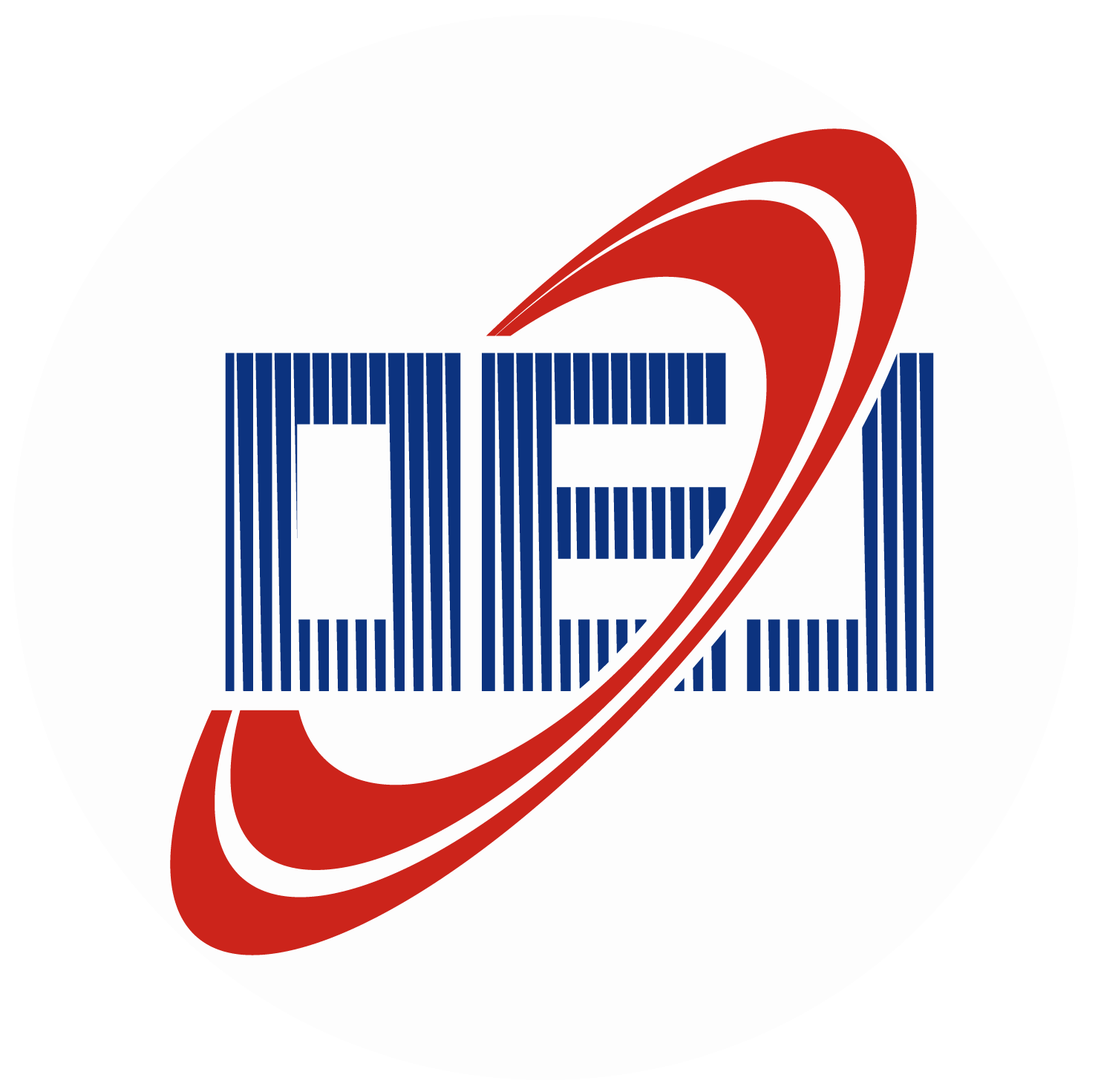

 E-mail Alert
E-mail Alert RSS
RSS


